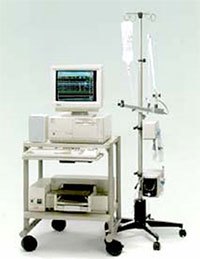What is the Urodynamics System?
Urodynamic Assessment is a highly specialised and sophisticated method of making an accurate diagnosis of the cause of incontinence.

The Urodynamic system measures the important functions of the bladder. This is used to measure, integrate and correlate
- Urine flow rate
- Bladder capacity, muscular control and
- Nervous control
This assessment is relatively inexpensive, takes approximately 45 minutes, does not require the use of drugs and is painless.
Why Has a Urodynamic Test Been Recommended?
A urodynamic diagnostic test is recommended to rule out or confirm certain disorders of the urinary bladder and urethra. These disorders include:
- Neurogenic bladder dysfunction,
- Spinal cord injury
- Multiple sclerosis
- Diabetes.
Other conditions that warrant testing bladder strength by using Urodynamic in trauma and age-related issues.
Urodynamic is also indicated in patients with complicated medical histories, incontinence not responsive to surgery or medical therapy and nocturnal enuresis.
What Does a Urodynamic Test Involve
The principal investigations are:
| Investigation | Symptoms | Possible diagnosis |
| Uroflow | Frequency, nocturia, poor flow | Bladder outlet obstruction |
| Pressure flow | Frequency, nocturia, poor flow | Bladder outlet obstruction |
| Cystometry | Frequency, urgency | Detrusor instability |
| Urethral closure pressure | Incontinence | Genuine stress incontinence |
| Ambulatory urodynamics | Frequency, urgency pointing to the unstable bladder but not shown on static urodynamics | Detrusor instability, Genuine stress incontinence |
What is Assessed and Detected using Urodynamics?
Urodynamic Assessment accurately detects most abnormalities. Depending on the diagnosis, the treatment recommended may include the
- taking of certain drugs,
- special pelvic floor exercises,
- physiotherapy or
- possible surgery.
How Do You Prepare for Urodynamic Diagnostic Test?
In order to prepare for the procedure, the patient should be adequately counselled to ensure that the informed consent obtained is fully understood.
The doctor then records a complete history and conducts a physical examination to ensure that the patient is a good fit for the procedure and in good health.
There is no special preparation and not clothing requirements for a Urodynamic Diagnostic Test, but generally comfortable clothes should be working.
Urodynamics Procedure
The procedure is performed by using small size catheters in the
- urinary bladder,
- urethra, and
- rectum.
The fluid is filled up in the bladder and pressures are monitored to get a feel about the lower urinary function.
The tubes are connected to machines and a computer calculates various pressures and guides about disease entities.
It is not advisable to take the test if there any urinary infection.
How Long Will Your Test Results Take?
Whereas some results may be available instantly, it usually takes a few days to get complete test results back and the results will be discussed at your next appointment.
After Urodynamic Diagnostic Test,
There is no recovery time required after this procedure or any special precautions to be practised.
Patients are free to continue their normal routines and diet without concern. The doctor will advise extra intake of fluids to make it easier to urinate for the first few days.
The doctor may prescribe antibiotics to prevent an infection. It's normal to see blood in the urine after the test, which will lessen with time.
How Often Is Urodynamic Assessment Necessary?
In most cases, a single visit is all that is required.
With the extremely accurate diagnosis and the provision of recommended treatment, most people should find that their problems, if not totally solved, are markedly improved.
How Can Urodynamic Assessment Be Arranged?
You will be referred by Dr Gianduzzo to one of his colleagues Dr Anthony Kiosoglous who performs the test. Dr Gianduzzo will write a referral for the test and then you will need to contact Dr Kiosoglous’ office to arrange the procedure.
What Are the Consequences of Not Conducting Urodynamic Test?
There are no consequences directly related to not taking the diagnostic test. However, by not identifying the nature of a bladder disorder and the functional attributes, may result in delaying an accurate diagnosis or the selection of an incorrect therapy, hindering recovery.




